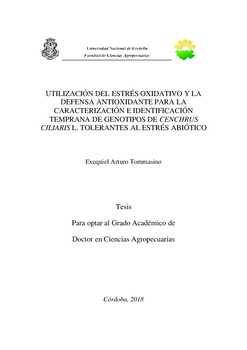| dc.contributor.advisor | Luna, Celina Mercedes | |
| dc.contributor.author | Tommasino, Exequiel Arturo | |
| dc.date.accessioned | 2019-04-09T15:45:55Z | |
| dc.date.available | 2019-04-09T15:45:55Z | |
| dc.date.issued | 2018 | |
| dc.identifier.uri | http://hdl.handle.net/11086/11386 | |
| dc.description | Tesis (Doctor en Ciencias Agropecuarias) -- UNC- Facultad de Ciencias Agropecuarias, 2018 | es |
| dc.description.abstract | La sequía y el estrés por calor son dos tipos de estrés abiótico importantes que afectan el crecimiento de los cultivos y la agricultura en todo el mundo. Muchos estudios se han enfocado en analizar la respuesta de los cultivos aplicando un solo estrés, sin embargo, estudiar la respuesta de las plantas a una combinación de estrés puede ser crítico para la comprensión de la tolerancia en las plantas y el desarrollo de genotipos tolerantes. El buffel grass (Cenchrus ciliaris L.) es una pastura subtropical conocida en las regiones áridas y semiáridas del mundo por su productividad y calidad del forraje, y por su mayor tolerancia al estrés por calor y sequía en relación a otras especies forrajeras subtropicales. Sin embargo, varias accesiones han exhibido diferentes respuestas a distintos tipos de estrés abiótico. El objetivo de este trabajo fue evaluar los efectos de la combinación de sequía y calor sobre los parámetros bioquímicos y morfológicos de las plantas y comparar los impactos de los factores limitantes al ser aplicados por separado y cuando se combinan, con la finalidad de obtener sistemas experimentales para evaluar la tolerancia de buffel grass en condiciones controladas y aportar herramientas para la identificación de genotipos tolerantes. Los resultados obtenidos, indican que la sequía y el calor causan alteraciones en el metabolismo oxidativo y generan cambios bioquímicos y de crecimiento en los genotipos de buffel grass, existiendo respuestas variables según los genotipos. Sequía y calor, aplicados de manera individual o en combinación causaron cambios en el metabolismo oxidativo, demostrado por la disminución de la actividad de enzimas antioxidantes y el incremento de la peroxidación lipídica. El genotipo susceptible exhibió mayor contenido de malondialdehído, menor poder reductor y baja actividad de las enzimas antioxidantes en comparación con el genotipo tolerante en los estreses por sequía y calor, aplicados en forma individual o en combinación. Esto puede resultar una herramienta importante en un programa de mejoramiento para la caracterización y diferenciación de genotipos de buffel grass tolerantes con mejor crecimiento bajo las condiciones de estrés evaluadas. | es |
| dc.description.abstract | Drought and heat stress are two criticalthreats to crop growth and sustainable agriculture worldwide. Many studies focused on the response of crops to a single stress, nevertheless studying the response of plants to a combination stress may be critical to our understanding of stress tolerance in plants and the development of tolerant genotypes. Buffel grass (Cenchrus ciliarisL.) is a warm-season grass known in arid and semiarid regions for its tolerance to heat and drought stress, productivity, and forage quality. However, several accessions have exhibited different responses to abiotic stresses. Therefore, the objective of this work was to evaluate the effects of the combination of drought and heat on the biochemical and morphological parameters inplants,and to compare the impacts of these limiting factors when applied separately and when combined, in order to develop experimental systems for toleranceevaluationsofbuffel grass in controlled conditions and provide tools for the identification of tolerant genotypes.. Theresults indicate thatdrought and heat greatly disrupt oxidative metabolism and generate biochemical and growth performance changes in buffel grass genotypes with variable responses.Individual drought or heat, and the combination, induce oxidative damage in buffel grass genotypes, as demonstrated in the present study, by the reduction in antioxidant enzyme activities and increase in lipid peroxidation. The sensitive genotype exhibited higher malondialdehydecontent, lower reducingpower, and reduced catalaseand superoxide dismutaseactivities than tolerant under drought or heat stress or a combination of both stresses.This can be an important tool for the selection of genotypes in buffel grass breeding program, which allow us to develop strategies for selection of tolerant genotypes with better growth performance under drought and heat conditions. | en |
| dc.format.extent | 112 h. : gráficos | es |
| dc.language.iso | spa | es |
| dc.rights | Attribution-NonCommercial-NoDerivatives 4.0 Internacional | * |
| dc.rights.uri | http://creativecommons.org/licenses/by-nc-nd/4.0/ | * |
| dc.subject | Cenchrus ciliaris | es |
| dc.subject | Buffel grass | es |
| dc.subject | Estrés hídrico | es |
| dc.subject | Estrés térmico | es |
| dc.subject | Oxidación | es |
| dc.subject | Estrés abiótico | es |
| dc.subject | Resistencia a agentes dañinos | es |
| dc.subject | Genotipos | es |
| dc.title | Utilización del estrés oxidativo y la defensa antioxidante para la caracterización e identificación temprana de genotipos de Cenchrus ciliaris L. tolerantes al estrés abiótico | es |
| dc.type | doctoralThesis | es |





